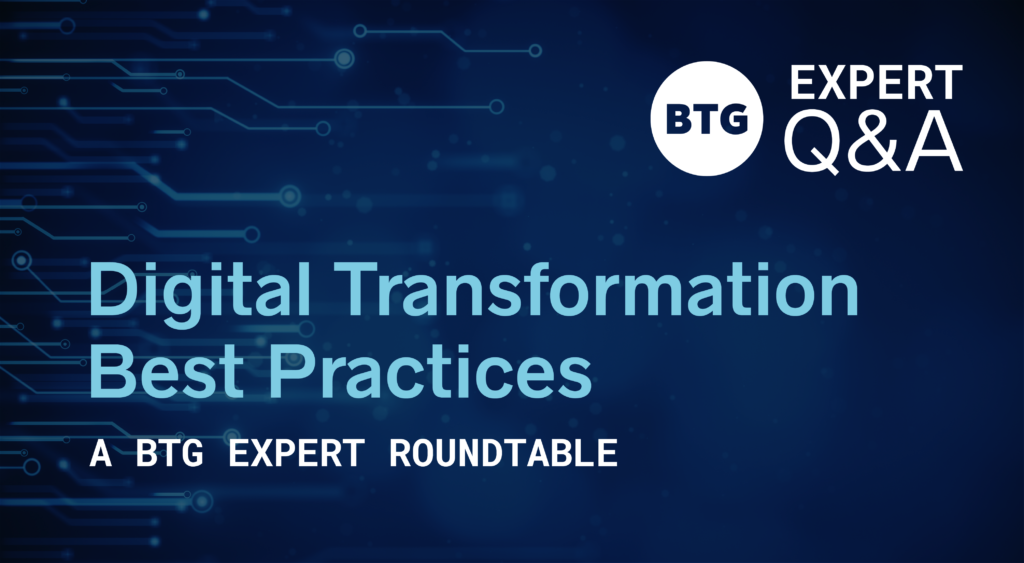Digital Transformation Best Practices: A BTG Expert Roundtable

Companies across industries are working hard to conduct business in a new (and much more virtual) reality—to create frictionless online customer experiences, streamline supply chains, enable remote workforces, and leverage data. These digital transformation initiatives require much more than just plugging in new tech. They entail strategy and planning across teams, company-wide culture changes, executive buy-in, and enhanced communication with purposeful feedback loops.
To help ensure the success of your next digital transformation initiative, we asked several digital transformation experts in our talent network to answer some common questions and offer best practices garnered from their on-the-ground experience in the field.
Meet Our Experts

Edward Brooks
Strategy and transformation expert in robotics, RPA, and artificial intelligence

Nathan Gampel
Transformation program specialist

Dr. Mohammad Ghassemi
Data science, innovation, and artificial intelligence expert

Simon Metz
Agile and digital transformation, data analytics, and project management consultant

Alan Walker
Digital transformation thought leader, strategist, and implementer

Timothy Wilson
Change management executive in digital marketing, strategic planning, and sales
Digital Transformation Best Practices Part One: Planning
Q: When contemplating a digital transformation, what questions should a client ask themselves?
Alan Walker: The business should start by asking, “What do we want the digital transformation to achieve?” In other words, what are its objectives—Improved customer experiences? Reduced costs? Higher sales? If the business doesn’t know what its objectives are, then it risks wasting money and effort—and will never know whether the transformation is a success. If in doubt, check your business strategy. A ‘digital strategy’ shouldn’t exist standalone. The question is what can ‘digital’ do to help deliver the business strategy.
Dr. Mohammad Ghassemi: What are the expected business value, human and data resource requirements, estimated time-to-impact (short-, medium-, long-term), costs, and business impact category (cost side, revenue side, innovation) that we expect from the digital transformation effort? Does the technology solve an important problem or create an opportunity for the business? If so, how long will the solution last, and is the technology the most cost effective and scalable way to solve the problem?
Nathan Gampel: Are you prepared? Digital transformation is about more than implementing new technology or using Agile concepts in a loose way. Digital transformation is a mind shift. It is about modernizing how you work, your culture, and organization as much as it is about technology and infrastructure. A complete approach that includes change management and operating model are key determinants for success.
Q: What are some best practices that leaders can follow to leverage the digital tools they have already invested in?
Simon Metz: Ensure that the tools they have tell a comprehensive story. So many times I have worked with COOs, CIOs, and CMOs who purchase many tools that deliver siloed analytics or a siloed experience for customers. The ROI is therefore minimized.
Timothy Wilson: Leaders should ask which digital tools already in place are not being used or maximized to the extent that the project was justified for prioritization and why. Which tools are not meeting the original goals or expectations and why? Should these tools be scrapped, replaced, or adjusted, or is more training needed? Could an add-on capability increase utilization by the organization?
Dr. Mohammad Ghassemi: Identify several groups of people (both internally and externally) that are currently (or will be) potential end users of the digital tools. Quantify and compare the ways those tools are measurably improving the ability of people in those groups to perform the tasks that drive value back to the business. Use this information to inform how the tools can be expanded to solve other use cases.
Q: What training / change management / process changes would you recommend in order to maximize the use and adoption of digital technologies?
Edward Brooks: Focus on awareness (of what the tech can do), use cases (where you can apply the tech), and skills (needed to apply it). Then set small, tangible “victories.” But recognize that the only way you really succeed with anything is when it becomes embedded in your culture. As a senior leader, you have to drive that with your questions. If there is a job vacancy, your question becomes, “How can we automate it?” If reports focus on historical data, your question becomes, “How can we leverage data to create predictions?” If you are launching a new product, your question becomes, “Can we embed AI in this product to transform this offering?”
Simon Metz: In today’s world, Agile processes and lean waste removal are a must–have. I have trained and managed projects in financial services, CPG, and manufacturing using Agile and seen enormous improvements. In the ever-changing world of COVID, Agile and the ability to constantly measure and pivot are essential. Servant leadership and removing organizational and technology debt are also critical.
Timothy Wilson: Change management techniques need to be a part of every project from the onset, rather than simply a back-end communication announcing that the new capability has been launched. Interview the people who are going to use the digital tool and involve them by building the capability around their processes. Or better yet, improve their processes as the digital tool is implemented. Include end-users during development and provide training before the launch.
Q: Dollar for dollar, what would be the smartest area(s) to invest in a digital transformation effort?
Dr. Mohammad Ghassemi:
- Augmented Intelligence: Use Artificial Intelligence to augment, rather than replace, human efforts within the organization.
- Data Ingestion Pipelines: Infrastructure to ingest and pre-process disparate data sources (both within and outside the organization) into a unified format that is amenable to statistical analysis and training AI methods.
- Technology Containerization: Packaging all technologies and their dependencies into modular, self-contained applications (e.g., via Docker/Kubernetes)
Simon Metz: Detailed analytics, data collection, and insight development are connected to every digital transformation that I have designed and managed. It’s important to collect the data that you need in a well–thought–out schema. Don’t rush this, as it will eliminate the value if the data schema is not designed with actual users. Architects may design a “correct” schema, but business owners must be involved so that the data is usable and insights can be developed on a regular basis. Once you have analytics and insights, a COO/CIO/CMO will have insights at their fingertips to lead them to additional investments in digital and technology.
Edward Brooks: The tech is the easy part—it all works and has been proven to work in multiple organizations, so it will work for you. The problem is “change”—how do you really force a “culture of digital” in your organization?
The answer is pretty simple. Look at what the best coaches say on this subject: Make a commitment and create public accountability. So, create your strategy and then publish it—internally and externally. Share with your stakeholders, suppliers, staff, advisors, bankers, consultants, etc. Tell them that you are going to invest in leading-edge technologies to make your company the most amazing place to work, the most amazing company to partner with, the most amazing company to supply to, with amazing products and services for your customers.
Then commit to reporting publicly to this audience on the last day of every month with the progress you are making. Not only is this free, it also creates amazing accountability. And that drives results.
Nathan Gampel: Every organization is different, and there is no single area that fits all. The key is to understand your goals and vision and then invest in a direct way. For example, if your digital transformation is about improving the customer experience, this may include investing in portals, websites, and digital channels to be sure, but it may also include developing marketing and data management practices to ensure companies take the most advantage of their newfound capabilities. This is transformation, which means it is large, strategic, and deep. If done properly it can be game changing. If not, it may be just another project. The right investment will depend on the strategy and depth to which the company wants to transform.
It is also important to invest in the right project management and governance structure. The right leader will know how to design the program and adjust how it moves throughout the transformation so the company can get the most out of its investment and people.
Digital Transformation Best Practices Part Two: Execution
Q: What are some of the biggest hurdles / pain points / showstoppers you have seen companies face during digital transformations? (And, if applicable, how could they best be avoided or addressed?)
Edward Brooks: We see four major hurdle points:
- Taking too long to get started, as well as losing time planning, strategizing, etc., thus missing out on the real value you get from doing
- Not believing that it will work, so only planning enough funds to get started—then having to pause, get approvals, get funding, etc., which results in a loss of momentum
- Not scaling fast enough—again, having to stop to get more approvals and funding
- Not embedding digital (and the core competencies, e.g., automation, data, cybersecurity, etc.) in the culture of the organization
Timothy Wilson: Once you get leadership buy-in for funding and priority, the hurdles to avoid include:
- Loss of momentum or priority over time (solution is stakeholder management and periodic reviews)
- No quick wins to keep the teams engaged (solution is to identify and communicate some small wins quickly)
- Technical delays or loss of capability (solution is to avoid the big bang launch and to phase in smaller capabilities over time to build credibility)
- Lack of consistent data against the goals (Up front along with metrics, agree on how the data will be collected and shared.)
Nathan Gampel: Improper investment in change management and communications. Most companies elect to spend heavily on the “hard skills” and technologies but neglect the right change management program. Not investing enough in creating the right climate for change is often a significant blind spot. This includes standing up the right program infrastructure.
Aligning leadership is another frequent challenge for a successful initiative. Transformation is hard, and when you are going through it, the change can be ugly at times. Ensuring leaders are aligned, engaged, and supportive is key. The right program structure and governance are important determinants for success because they ensure leaders remain aligned and supportive throughout the life of the program.
Q: How would you position where you as an independent can be helpful compared to—or in conjunction with—a traditional consulting firm?
Simon Metz: As an independent contractor, I am fully dedicated to my projects. I don't have overhead that distracts me from always delivering the best possible outcomes to my clients. I create relationships with leaders and tell them the truth, and in my current engagement, I have global leaders that depend on my inputs, KPIs, and models. I deliver my endgame to requirements plus an expansive set of additional capabilities such as deep technical know-how, workflow optimization, marketing, SEO, and Agile training and coaching.
Unlike FTEs or consultants from large firms, I jump in on the spot where I can leverage my expertise to improve outcomes. I don't try to add resources to a project when a client needs something additional that I can deliver.
From a purely financial perspective, traditional consulting firms have partners that provide oversight but many times less value on the ground and are charged to clients usually at $500–$1,000 per hour. Consulting firms then depend on very junior resources to create attractive margins, but these resources—typically with no more than 2–3 years of experience—do not have the depth and breadth of experience to think on their feet and answer questions in meetings.
Dr. Mohammad Ghassemi: Independent consultants often come from unique backgrounds (e.g., university professors or founders of small companies) and may have deeper expertise than those embedded within traditional consulting firms—which are necessarily more broadly focused.
Timothy Wilson: Independents are more flexible, nimble, and affordable than a big firm. A big firm is great for a multi-year, multi-pronged digital transformation involving many different systems and groups. A big firm can bring large capability across the platform over a long period of time. The value of an independent is that they have the exact experience you need for the time and cost that is most effective for your biggest headaches without a large and expensive contract. Independents can get in and get out quickly and efficiently. Most independents can be approved by a lower-level manager for a short-term project. Engaging with a big firm usually involves purchasing and high-level manager approval for a multi-year relationship.
Alan Walker: Traditional consulting firms offer significant amounts of delivery bandwidth and a “single throat to choke”—both of which can be very valuable. But their business model depends on scale, so they’re usually less willing to sell you an individual expert—unaccompanied by a bigger team—who can be your trusted advisor, or someone to fulfill a specific role you can’t staff yourself. In both of these latter cases, independents come into their own and often offer significantly higher value for money, even at equivalent rates.
Q: How can companies get the entire organization aligned behind their digital transformations?
Simon Metz: Engage a broad spectrum of the organization in planning sessions. Report what is working and what is not working, be Agile, and admit when the transformation needs to pivot. For political reasons I have seen many times where people won’t admit that a tactic or technology that was previously planned is no longer the right fit.
Ask tough questions of those who may execute the transformation: Is there enough value? Can we achieve what we are planning? Are we investing in the right people? Are there experts that we should bring in to partner for the success of the transformation?
Dr. Mohammad Ghassemi: By emphasizing the role of digital transformation in augmenting, not automating, processes in the organization. Digital transformation, when done right, doesn’t automate people away—it makes them more efficient.
Timothy Wilson: Organizational alignment happens when the strategy and goals are well communicated and understood and when the digital transformation program enables that end result via a roadmap document. If the organization can achieve the end result without the digital transformation program, then other programs can and will take priority and mind share. Periodic updates (even bad news and how you will fix it) on where the organization is on the roadmap keep folks engaged and aligned.
Digital Transformation Best Practices Part Three: The Big Picture
Q: What are the top trends in digital transformation right now?
Simon Metz: Digital is a broad set of areas, often a misnomer as everything today is “digital” in some respects. The top trends that I see in small and large enterprises are:
- Data and analytics
- Machine learning (what-if scenarios and leveraging the paths for insights that drive production, sales, investments, etc.)
- Agile methodology, lean approaches, smaller lightweight teams, minimum viable product releases of products and services
- Early thinking on the “next billion-dollar business”—don’t expect that what sells now will sell tomorrow.
- Technology upgrades—during COVID many enterprises lacked the basic technology to allow remote work to continue. Large banks had almost no support because they had antiquated technology (such as mainframes) that are difficult to remotely access and configure.
Alan Walker: The whole topic of digital transformation has suddenly received a major boost in pretty much every industry, courtesy of the COVID-19 pandemic. For all that has been awful about the disease, it has forced businesses to accelerate their use of digital technologies (particularly in relation to remote working and digital customer channels). It has also shown them how much more beneficial some of these technologies have been, with much higher adoption rates than they imagined. As a result, almost every business I’m talking to plans to ramp up digital transformation efforts significantly over the next 12 to 18 months.
Edward Brooks:
- Cybersecurity never goes away—embed it in your culture.
- Automation/robotic process automation (RPA) has been around for years, but most organizations are only 1% down their journey.
- Data is the most valuable resource you are sitting on. It will drive AI and give you insights and predictions that were impossible to get even a few years ago.
Q: What advice would you give a client right now who is contemplating starting, stopping, or continuing a digital transformation?
Alan Walker : If you’re contemplating starting: good for you, you’re not yet too late. If you’re contemplating stopping: unless you’re stopping just to regroup and redouble your efforts, you might want to reconsider whether you’ll end up on the right side of history. If you’re continuing a digital transformation: excellent—you’re very sensible. But, in the aftermath of COVID-19, do you now need to change even more quickly?
Edward Brooks: If you are not doing digital now, you will be next week or next year. So, the sooner you get deep into digital the sooner you get to the real challenges and then access the insane benefits.
Timothy Wilson: My advice is to start with a basic assessment. Where are you now? Where do you want to be? What are the key projects, and in what priority will these take you there? What assets (budget, time, people, tools) do you have now and what assets are needed for successful completion? What capabilities do you have and which do you need to add going forward over what period of time? Can you develop capabilities inhouse or should you go outside the company? Is this a short-term or long-term need for outside resources? Where is the best place to quickly and successfully find what you need?
Based on the above, create a roadmap of what success looks like over the next month, quarter, year, and five years and use that document to communicate and align against budgets and priorities up and down the organization.
Nathan Gampel: Get a second set of eyes. I see clients doing this a lot—even before recent events. Transformation is very disruptive and can be very expensive both in terms of dollars and lost cohesiveness across teams. Sometimes stopping is the right decision, but other times it is about resetting expectations. This is where preliminary assessments can be priceless.
Whether you’re starting a new digital transformation or you already have an actionable roadmap in hand, your initiative probably has a lot of moving parts—and a lot at stake! By following our experts’ best practices and advice, you can start your digital transformations on the right foot, avoid the most common pitfalls, and generate stakeholder buy-in and organizational alignment behind your initiatives.
GET THE SKILLS YOU NEED
Thousands of independent consultants, subject matter experts, project managers, and interim executives are ready to help address your biggest business opportunities.